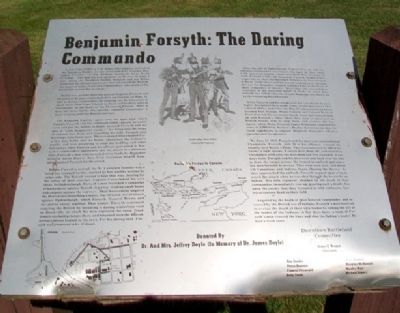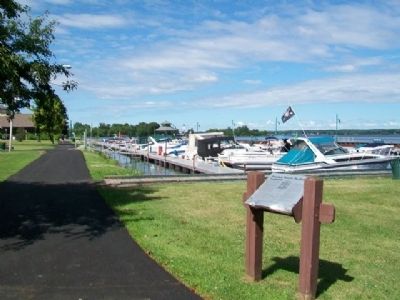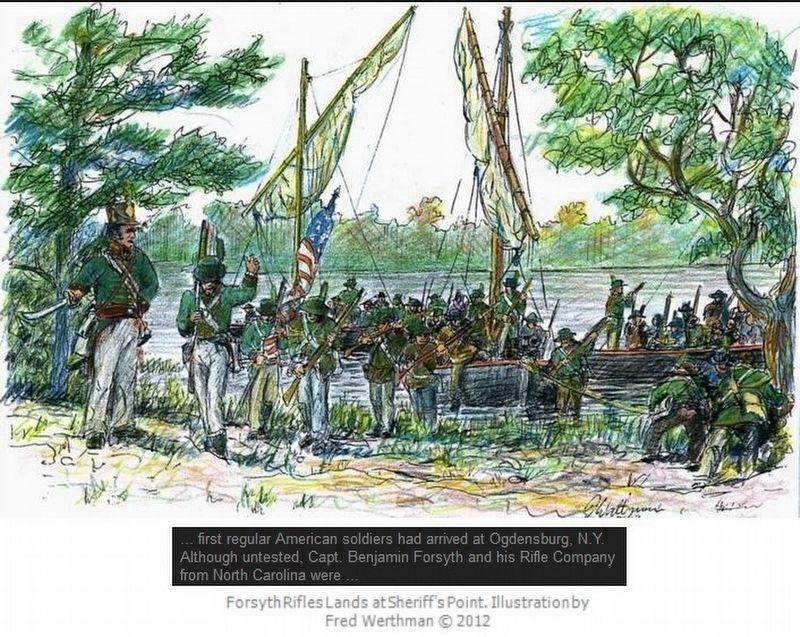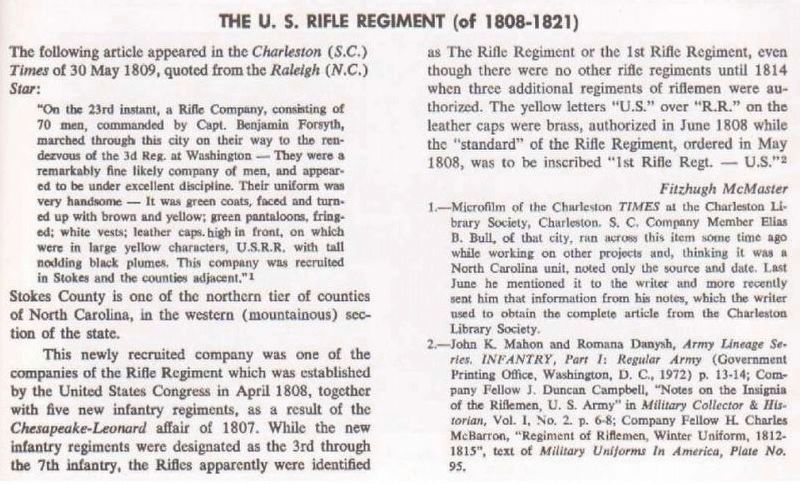Ogdensburg in St. Lawrence County, New York — The American Northeast (Mid-Atlantic)
Benjamin Forsyth: The Daring Commando
Ogdensburg Battlefield Trail
In late July of 1812, a U.S. Army rifle company arrived on the Northern Border. It was commanded by Captain Benjamin Forsyth, "a big dashing daredevil from North Carolina," who had his own opinions on the way to wage a war. Along the Northern border, Forsyth and his Rifles pioneered the hit and run tactics that infuriated the British, and angered many of his own commanders, who disliked his brash and unorthodox methods.
Within two months after his arrival, Captain Forsyth and his force of 95 men established their reputations on Sept. 21, 1812 as daring commandoes by crossing the St. Lawrence in small boats from Cape Vincent at dawn and landing west of Gananoque, in the heart of the Thousand Islands. After a brief but fierce battle, they quickly captured Gananoque, a major staging point for British convoys.
The Kingston Gazette, upset over the ease with which Captain Forsyth and his command could capture an entire town and put the militia to flight, accused Forsyth and his men of "truly disgraceful conduct" for firing into the home of Colonel Joel Stone and wounding his wife. Forsyth said his troops were fired upon. The newspaper also claimed Forsyth's men broke into the house, ransacked the Colonel's trunks, and were preparing to steal his bedding and other belongings when Forsyth and his officers prevented it. Forsyth's commanders apparently saw the attack in a different light. Forsyth's men were awarded state funds by Brigadier General Jacob Brown. New York Governor Daniel Thompkins praised Forsyth for the attack.
Before Forsyth's arrival, the St. Lawrence frontier was a relatively tranquil border, marked by a few warlike actions by either side. The British wanted it kept that way, fearing for the safety of their convoys. Captain Forsyth had his own ideas. In Ogdensburgh, Forsyth's men launched a campaign of harassment against British shipping, sending small boats and snipers against the convoys. Their harassment angered the British into launching a major, but ill-fated, naval attack against Ogdensburgh, which Forsyth, General Brown and the militia easily repelled. That winter, Forsyth continued angering the British by mounting a daring wintertime raid on Brockville, in which his men captured the town, freed Americans being held prisoner there, and returned with the British military stores housed in the town. For his daring raid, Forsyth was promoted to Lt. Colonel.
After the fall of Odgensburgh, Colonel Forsyth and his riflemen continued to win renown. On April 26, 1813, when 1,700 American regular troops launched their invasion of York, Forsyth's rifles led the attack. Forsyth, despite heavy sniper fire on their flat-bottomed Schenectady boats landed at 8 a.m. on the shore with his assault landing force, clearing the way for Brigadier General Zebulon Pike at the head of three companies of infantry. More than 320 were killed or wounded in the succeeful [sic] battle of York, in which Pike himself was killed when the Grand Magazine was blown up by the retreating British troops.
While Forsyth and his troops were not considered the most highly disciplined force in the Army, no one questioned their valor or ability under fire. On May 27, when American forces invaded Fort George, Major Forsyth and Colonel Winfield Scott directed the successful attack. Scott and Forsyth landed with Forsyth's rifles where they soon overpowered the British troops sent to stop them, and overran the fort. Again, when Major General James Wilkinson launched his army of 8,000 from Sackett's Harbor downriver on their ill-fated expedition to capture Montreal, Forsyth's riflemen spearheaded the advance.
By June 22, 1813, Forsyth and his men were stationed near Champlain. Forsyth, with 70 of his riflemen, crossed the frontier near Rouse's Point. They were attacked by 200 of the enemy's light troops. Forsyth beat them off, and retired to Champlain with only one man dead and five wounded. A few days later, Forsyth and his men were sent back over the line to draw the enemy across. He formed an ambush and sent a few men forwards as decoys. They were soon seen,
and about 150 Canadians and Indians began chasing the decoys. As they approached the ambush, Forsyth stepped upon a log to watch the attack when he was shot through the breast by an Indian. His rifle regiment, shocked by the death of their commander, immediately rose up, pouring such a deadly fire upon the enemy that they retreated in wild confusion, leaving seventeen dead on their field.
Angered by the death of their beloved commander, and incensed by the British use of Indians, Forsyth's men resolved to avenge the death of their own leader by taking the life of the leader of the Indians. A few days later, a team of Forsyth's men crossed the lines and shot the Indian's leader. He died a week later.
Erected by Dr. and Mrs. Jeffrey Doyle in memory of Dr. James Doyle and the Downtown Battlefield Committee.
Topics. This historical marker is listed in this topic list: War of 1812. A significant historical month for this entry is April 1923.
Location. 44° 42.009′ N, 75° 29.702′ W. Marker is in Ogdensburg, New York, in St. Lawrence County. Marker is along the walking path in Morissette Park, just east of the marina slips, and about 200 feet NNW of the intersection of Riverside Avenue and State Street. Touch for map. Marker is in this post office area: Ogdensburg NY 13669, United States of America. Touch for directions.
Other nearby markers. At least 8 other markers are within walking distance of this marker. What Happened To The Patriots (a few steps from
this marker); Ogdensburgh And The War (a few steps from this marker); The Attack on the Village (within shouting distance of this marker); Sheriff Joseph York’s Stand (within shouting distance of this marker); North Country Sailors' Memorial (within shouting distance of this marker); Attack on the Fort (about 400 feet away, measured in a direct line); Civil War Soldiers' and Sailors' Memorial (about 400 feet away); How Ogdensburgh Captured Brockville (about 500 feet away). Touch for a list and map of all markers in Ogdensburg.
Also see . . .
1. The War of 1812 in the North Country: 200 years later. North Country Now website entry (Submitted on July 27, 2014, by William Fischer, Jr. of Scranton, Pennsylvania.)
2. Benjamin Forsyth. Virtualology.com website entry (Submitted on July 27, 2014, by William Fischer, Jr. of Scranton, Pennsylvania.)
3. Origins of "Sharpshooter". TOCWOC website entry (Submitted on July 27, 2014, by William Fischer, Jr. of Scranton, Pennsylvania.)
Credits. This page was last revised on August 20, 2023. It was originally submitted on July 27, 2014, by William Fischer, Jr. of Scranton, Pennsylvania. This page has been viewed 699 times since then and 53 times this year. Photos: 1, 2. submitted on July 27, 2014, by William Fischer, Jr. of Scranton, Pennsylvania. 3. submitted on April 22, 2021, by Russ Grimm of Hampton, Virginia. 4. submitted on September 5, 2021, by Russ Grimm of Hampton, Virginia.



